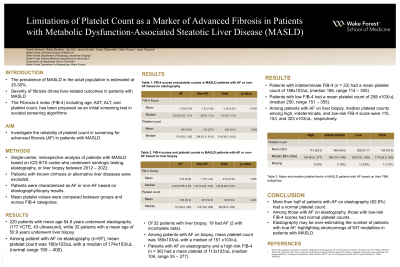Monday Poster Session
Category: Liver
P2888 - Limitations of Platelet Count as a Marker of Advanced Fibrosis in Patients With MASLD
Monday, October 28, 2024
10:30 AM - 4:00 PM ET
Location: Exhibit Hall E


Frank Ventura, MD
Wake Forest University School of Medicine
Winston-Salem, NC
Presenting Author(s)
Frank Ventura, MD1, Blake Bentley, MD2, Jao Ou, MD1, Jacob Bundy, MD1, Corey Obermmiller, 2, Sean Rudnick, MD2
1Wake Forest University School of Medicine, Winston-Salem, NC; 2Atrium Health Wake Forest Baptist, Winston-Salem, NC
Introduction: The prevalence of metabolic dysfunction-associated steatotic liver disease (MASLD) in the adult population is estimated at 25-30%. Severity of fibrosis drives liver-related outcomes in patients with MASLD. Noninvasive testing (NIT) is increasingly used to risk-stratify patients. The Fibrosis-4 index (FIB-4) including age, AST, ALT, and platelet count, has been proposed as an initial screening test in societal guidelines. We aimed to investigate the reliability of platelet count in screening for advanced fibrosis (AF) in patients with MASLD.
Methods: Single-center, retrospective analysis of patients with MASLD based on ICD-9/10 codes who underwent serologic testing, elastography, and/or liver biopsy between 2012 – 2022. Patients with known cirrhosis or alternative liver diseases were excluded. Patients were characterized as AF or non-AF based on elastography/biopsy results. Mean platelet values were compared between groups and across FIB-4 categories.
Results: 220 patients with mean age 54.8 years underwent elastography (177 VCTE, 43 ultrasound), while 32 patients with a mean age of 50.9 years underwent liver biopsy. Among patient with AF on elastography (n=97), mean platelet count was 180x103/uL with a median of 174x103/uL (normal range 150 – 400). Of 32 patients with liver biopsy, 19 had AF (2 with incomplete data). Mean platelet count was 185x103/uL with a median of 151 x103/uL. Platelet counts were compared between FIB-4 categories. Patients with AF on elastography and a high-risk FIB-4 (n = 36) had a mean platelet of 113x103/uL (median 104, range 35 – 277). Patients with indeterminate FIB-4 (n = 33) had a mean platelet count of 188x103/uL (median 186, range 114 – 305), while patients with low FIB-4 had a mean platelet count of 258 x103/uL (median 250, range 151 – 355). Among patients with AF on liver biopsy (n=17), median platelet counts among high, indeterminate, and low-risk FIB-4 score were 110, 153, and 323 x103/uL, respectively.
Discussion: More than half of patients with AF on elastography (62.8%) had a normal platelet count. Among those with AF on elastography, those with low-risk FIB-4 scores had normal platelet counts. These results suggest that platelet count may not be as reliable an indicator of AF for patients with MASLD compared to other etiologies of liver diseases, or that elastography is over-estimating the number of patients with true AF, highlighting shortcomings of NIT modalities in patients with MASLD.
Note: The table for this abstract can be viewed in the ePoster Gallery section of the ACG 2024 ePoster Site or in The American Journal of Gastroenterology's abstract supplement issue, both of which will be available starting October 27, 2024.
Disclosures:
Frank Ventura, MD1, Blake Bentley, MD2, Jao Ou, MD1, Jacob Bundy, MD1, Corey Obermmiller, 2, Sean Rudnick, MD2. P2888 - Limitations of Platelet Count as a Marker of Advanced Fibrosis in Patients With MASLD, ACG 2024 Annual Scientific Meeting Abstracts. Philadelphia, PA: American College of Gastroenterology.
1Wake Forest University School of Medicine, Winston-Salem, NC; 2Atrium Health Wake Forest Baptist, Winston-Salem, NC
Introduction: The prevalence of metabolic dysfunction-associated steatotic liver disease (MASLD) in the adult population is estimated at 25-30%. Severity of fibrosis drives liver-related outcomes in patients with MASLD. Noninvasive testing (NIT) is increasingly used to risk-stratify patients. The Fibrosis-4 index (FIB-4) including age, AST, ALT, and platelet count, has been proposed as an initial screening test in societal guidelines. We aimed to investigate the reliability of platelet count in screening for advanced fibrosis (AF) in patients with MASLD.
Methods: Single-center, retrospective analysis of patients with MASLD based on ICD-9/10 codes who underwent serologic testing, elastography, and/or liver biopsy between 2012 – 2022. Patients with known cirrhosis or alternative liver diseases were excluded. Patients were characterized as AF or non-AF based on elastography/biopsy results. Mean platelet values were compared between groups and across FIB-4 categories.
Results: 220 patients with mean age 54.8 years underwent elastography (177 VCTE, 43 ultrasound), while 32 patients with a mean age of 50.9 years underwent liver biopsy. Among patient with AF on elastography (n=97), mean platelet count was 180x103/uL with a median of 174x103/uL (normal range 150 – 400). Of 32 patients with liver biopsy, 19 had AF (2 with incomplete data). Mean platelet count was 185x103/uL with a median of 151 x103/uL. Platelet counts were compared between FIB-4 categories. Patients with AF on elastography and a high-risk FIB-4 (n = 36) had a mean platelet of 113x103/uL (median 104, range 35 – 277). Patients with indeterminate FIB-4 (n = 33) had a mean platelet count of 188x103/uL (median 186, range 114 – 305), while patients with low FIB-4 had a mean platelet count of 258 x103/uL (median 250, range 151 – 355). Among patients with AF on liver biopsy (n=17), median platelet counts among high, indeterminate, and low-risk FIB-4 score were 110, 153, and 323 x103/uL, respectively.
Discussion: More than half of patients with AF on elastography (62.8%) had a normal platelet count. Among those with AF on elastography, those with low-risk FIB-4 scores had normal platelet counts. These results suggest that platelet count may not be as reliable an indicator of AF for patients with MASLD compared to other etiologies of liver diseases, or that elastography is over-estimating the number of patients with true AF, highlighting shortcomings of NIT modalities in patients with MASLD.
Note: The table for this abstract can be viewed in the ePoster Gallery section of the ACG 2024 ePoster Site or in The American Journal of Gastroenterology's abstract supplement issue, both of which will be available starting October 27, 2024.
Disclosures:
Frank Ventura indicated no relevant financial relationships.
Blake Bentley indicated no relevant financial relationships.
Jao Ou indicated no relevant financial relationships.
Jacob Bundy indicated no relevant financial relationships.
Corey Obermmiller indicated no relevant financial relationships.
Sean Rudnick indicated no relevant financial relationships.
Frank Ventura, MD1, Blake Bentley, MD2, Jao Ou, MD1, Jacob Bundy, MD1, Corey Obermmiller, 2, Sean Rudnick, MD2. P2888 - Limitations of Platelet Count as a Marker of Advanced Fibrosis in Patients With MASLD, ACG 2024 Annual Scientific Meeting Abstracts. Philadelphia, PA: American College of Gastroenterology.
